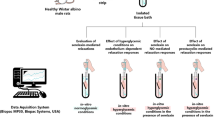Abstract
Background. It has been speculated for more than 2 decades whether there is a significance of adrenal corticosteroids, such as cortisol, in the process of normal male sexual function, especially in the control of sexual arousal and the penile erectile tissue. However, only few in vivo studies have been carried out up until now on the effects of cortisol on human male sexual performance and penile erection. In order to evaluate further the role of cortisol in male sexual activity, the present study was conducted to detect serum levels of cortisol in the systemic and cavernous blood taken during different penile conditions from healthy males. Material and Methods. The effects of cortisol derivative prednisolone, catecholamine norepinephrine (NE) and the peptide endothelin-1 (ET-1) on isolated human corpus cavernosum (HCC) were investigated using the organ bath technique. Fifty-four healthy adult male subjects were exposed to erotic stimuli in order to elicit penile tumescence and rigidity. Whole blood was simultaneously aspirated from the corpus cavernosum and the cubital vein during different penile conditions. Serum levels of cortisol (μg/dl) were determined by means of a radioimmunoassay (ELISA). Results. In the healthy volunteers, cortisol serum levels significantly decreased in the systemic circulation and the cavernous blood with increasing sexual arousal, when the flaccid penis became rigid. During detumescence, the mean cortisol level remained unaltered in the systemic circulation, whereas in the cavernous compartment, it was found to decrease further. Under all penile conditions, no significant differences were registered between cortisol levels in the systemic circulation and in the cavernous blood. Cumulative addition of NE and ET-1 (0.001–10 μM) induced contraction of isolated HCC strips, whereas the contractile response to prednisolone was negligible. Conclusion. Our results strongly suggest an inhibitory role for cortisol in the mechanism of male sexual response and behaviour. These properties are mediated rather via an effect on central structures than on the penile erectile tissue. Future studies to include patients suffering from erectile dysfunction may reveal whether or not there are differences in the cortisol serum profiles of healthy subjects and patients under different stages of sexual arousal.


Similar content being viewed by others
References
Andersson K-E, Wagner G (2001) Pharmacology of penile erection. Pharmacol Rev 53: 417
Becker AJ, Ückert S, Stief CG, Truss MC, Machtens S, Scheller F, Knapp WH, Hartmann U, Jonas U (2000) Cavernous and systemic testosterone levels in different phases of human penile erection. Urology 56: 125
Becker AJ, Ückert S, Stief CG, Truss MC, Hartmann U, Jonas U (2000) Systemic and cavernous plasma levels of endothelin in healthy males during different functional conditions of the penis. World J Urol 18: 227
Borg KE, Esbenshade KL, Johnson BH (1991) Cortisol, growth hormone, and testosterone concentrations during mating behaviour in bulls and boars. J Anim Sci 69: 230
Carani C, Bancroft Del Rio G, Granata AR, Facchinetti F, Marrama P (1990) The endocrine effects of visual erotic stimuli in normal men. Psychoneuroendocrinology 15: 207
Carlstedt-Duke J, Gustaffson JA (1987) Structure and function of the glucocorticoid receptor. J Steroid Biochem 27: 99
Derouet H, Lehmann J, Stamm B, Luhl C, Romer D, Georg T, Isenberg E, Gebhardt T, Stoeckle M (2002) Age-dependent secretion of LH and ACTH in healthy men and patients with erectile dysfunction. Eur Urol 41: 144
Granata A, Bancroft J, Del Rio G (1995) Stress and the erectile response to intracavernosal prostaglandin E1 in men with erectile dysfunction. Psychosom Med 57: 336
Gray A, Feldmann A, McKinlay JB, Longcope (1998) Age, disease and changing sex hormone levels in middle-aged men: Results of the Massachusetts Male Aging Study. J Endocrinol Metab 73: 1016
Hofmann W, Kluge R (1977) Cushing's Syndrome. Z Urol Nephrol 70: 141
Isidori A, Di Luigi L, Conte D (1984) ACTH 1–17 and sexual behaviour. Ric Clin Lab 14: 247
Joshua OA (1975) Dogs poxs: some clinical aspects of an eruptive condition of certain mucous surfaces in dogs. Vet Rec 96: 300
Jung GW, Spencer EM, Lue TF (1998) Growth hormone enhances regeneration of nitric oxide synthase-containing penile nerves after cavernous nerve neurotomy in rats. J Urol 160: 1899
Kandeel FR, Koussa VKT, Swerdloff RS (2001) Male sexual function and its disorders: physiology, pathophysiology, clinical investigation, and treatment. Endocrine Rev 22: 342
Meston CM, Penny F, Frohlich MA (2000) The neurobiology of sexual function. Arch Gen Psychiatry 57: 1012
Parker LN, Odell WD (1980) Control of adrenal androgen secretion. Endocrine Rev 1: 392
Penson DF, Ng C, Rajfer J, Gonzales-Cavidad NF (1997) Adrenal control of erectile function and nitric oxide synthase in the rat penis. Endocrinology 138: 3925
Rowland DL, Heiman JR, Gladue BA, Hatch JP, Doering CH, Weiler SJ (1987) Endocrine, psychological and genital response to sexual arousal in men. Psychoneuroendocrinology 12: 149
Sabais A (1999) Nicht-genomische Effekte von Gluco- und Mineralocorticoiden in isolierten Dickdarmepithelzellen von Meerschweinchen. Doctoral thesis, Hannover Technical University, Faculty of Chemistry, Hannover, pp 33
Simpson ER, Waterman MR (1988) Regulation of the synthesis of steroidogenic enzymes in adrenal cortical cells by ACTH. Ann Rev Physiol 50: 427
Starkman MN, Schteingart DE (1981) Neuropsychiatric manifestations of patients with Cushing's Syndrome. Relationship to cortisol and adrenocorticotropic hormone levels. Arch Intern Med 141: 215
Wehling M (1994) Nongenomic action of steroid hormones. Trends Endocrinol Metab 5: 347
Zvara P, Sioufi R, Schipper HM, Begin LR, Brock GB (1995) Nitric oxide mediated erectile activity is a testosterone-dependent event: a rat erection model. Int J Impot Res 7: 209
Acknowledgements
This work was supported by a grant from the Deutsche Forschungsgemeinschaft DFG (Be 2045/1–1/1–2).
Author information
Authors and Affiliations
Corresponding author
Rights and permissions
About this article
Cite this article
Ückert, S., Fuhlenriede, M.H., Becker, A.J. et al. Is there an inhibitory role of cortisol in the mechanism of male sexual arousal and penile erection?. Urol Res 31, 402–406 (2003). https://doi.org/10.1007/s00240-003-0359-5
Received:
Accepted:
Published:
Issue Date:
DOI: https://doi.org/10.1007/s00240-003-0359-5




